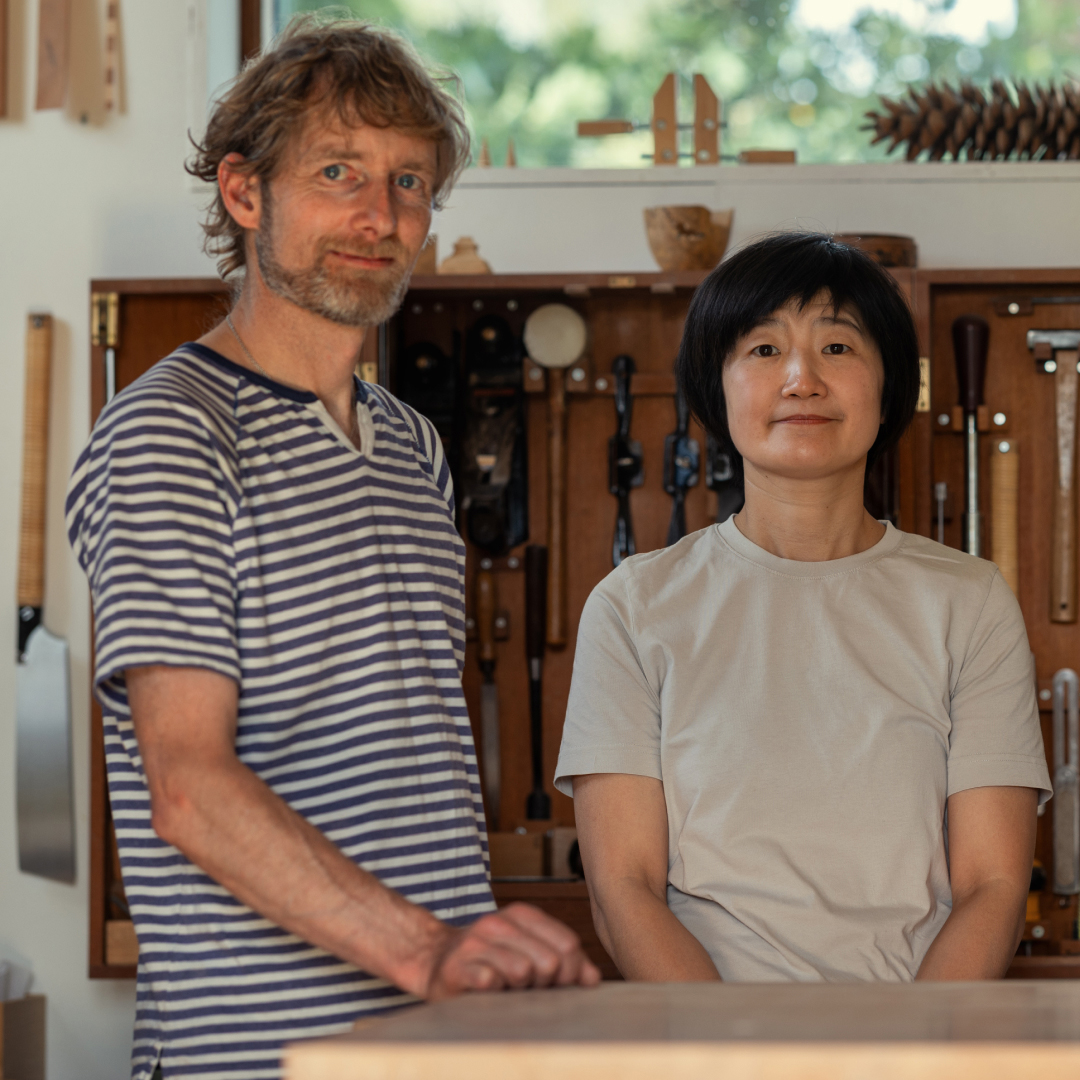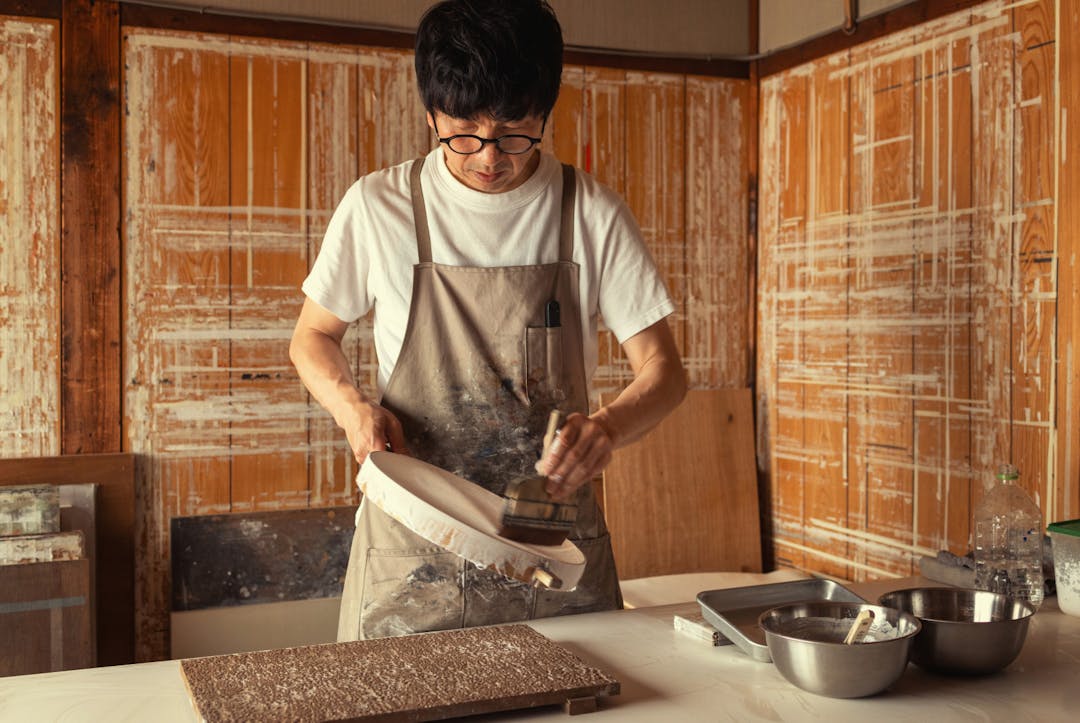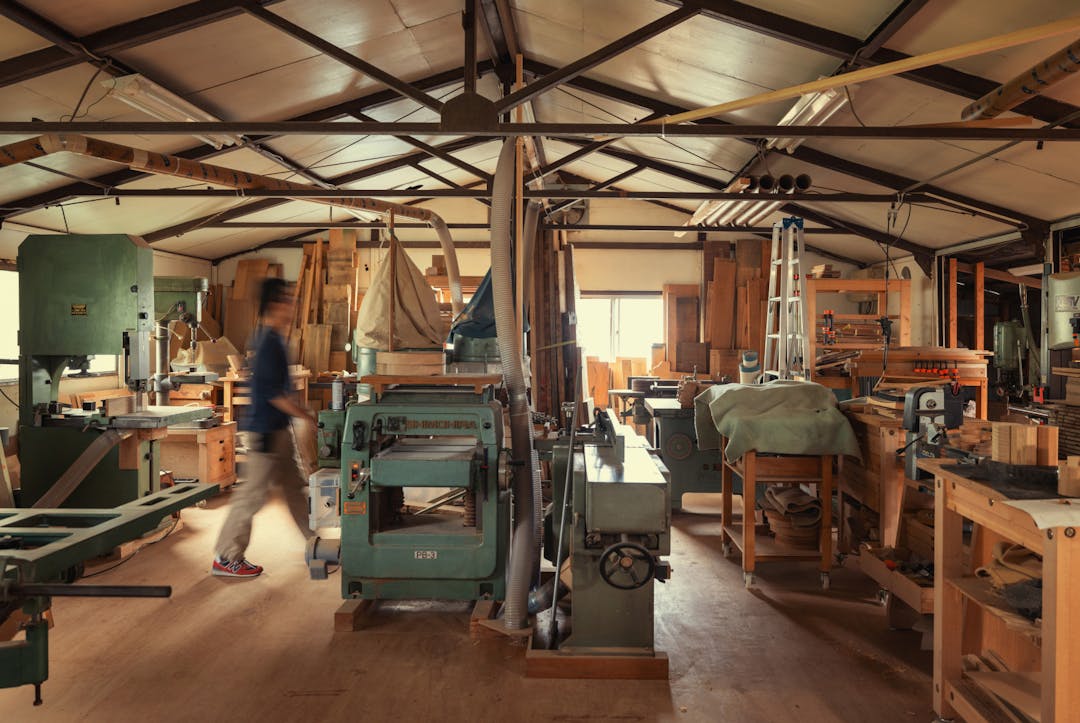
Play Movie

Listen
to Katherine Kennard
reading this story
Japanese-Danish woodworking artistry
Akiko Ken Made
Akiko Kuwahata and Ken Winther, cabinetmakers based in Copenhagen, are Japanese-Danish partners in both their personal and working lives. Despite coming from cultures thousands of kilometres apart, the two complement each other perfectly, resulting in objects of stunning beauty with clever twists. Their love of wood is contagious, their commitment to achieving perfection impressive. ‘Impossible’ simply isn’t part of this couple’s vocabulary when it comes to their craft.



First, it’s a suspicious growl, then a joyful leap. Akiko and Ken’s dog, a Danish-Swedish farm dog with brown and black spots on his short white fur, is highly adept at sensing everything happening around him – including the arrival of guests. “His name is Maru Chan,” explained Akiko and Ken as they greet us when we first met. In Japanese, “Maru” means circle, and “Chan” is a diminutive suffix, so his name roughly translates as ‘little circle’. And a circle, they believe, always signifies something good.
It’s early in the morning on a warm summer day in the garden of Akiko and Ken, in the north of Copenhagen. The light is still soft, the air fresh and clean. The only sounds are a few birds chirping and some bees humming as they collect nectar from wild roses and buttercups, and from the rich plum and apple trees around the house. A delicate smell of wood is perceptible in between, emanating from the workshop’s open door, hinting at what this place is about. The calmness of nature is present all around.
It’s early in the morning on a warm summer day in the garden of Akiko and Ken, in the north of Copenhagen. The light is still soft, the air fresh and clean. The only sounds are a few birds chirping and some bees humming as they collect nectar from wild roses and buttercups, and from the rich plum and apple trees around the house. A delicate smell of wood is perceptible in between, emanating from the workshop’s open door, hinting at what this place is about. The calmness of nature is present all around.
Akiko and Ken moved to this idyllic location over a decade ago. In the beginning, there was only their little house and the garden. Soon, they started constructing their workshop as well. “Actually, we moved here precisely for the purpose of building the workshop,” says Ken.

Their workshop is a rectangular space directly attached to their house. Ken built it with assistance from his father, friends and other carpenters. It features a monopitched roof, small square windows on one side, and larger windows facing the garden to allow the light in. In the centre, there’s a large table surrounded by various machines and an array of files, chisels and knives hung or stacked near the walls. And, of course, pieces of wood in all sizes, types and colours. It’s not just the scent of the pieces of wood that immediately evokes a feeling of warmth and tranquillity; it’s also the natural kindness and calmness that Akiko and Ken exude. While Akiko serves green tea in delicate Japanese pottery made from a friend, Ken patiently explains every machine, tool and object that we curiously inspect in the drawers and shelves. With a total area of 55 square metres, the workshop is small – too small for Akiko and Ken to work with any apprentices. But it’s big enough – perfect, in fact – for just the two of them.

Akiko and Ken met in 2004. Akiko, originally from Japan, was studying architecture in Aarhus at the time and visiting friends in Copenhagen. Mutual friends, as they soon found out. When Akiko and Ken were introduced to each other, they felt an instant connection. We ask whether it was love at first sight. “Sometimes you simply get blown away,” Ken recalls with a big smile on his face. Just a year later, they got married in a small ceremony with nine guests on the beach at Ken’s parents’ place in the north of Jutland.
Just a few minutes in their company is enough to notice the profound connection they share. It’s the calm and respectful tone in which they speak to each other in Danish. It’s the way they are fully immersed when they play with their dog together. Perhaps it’s also the fact that they wear the same model of loose-fitting cotton working trousers – Akiko in beige, Ken in khaki. And undoubtedly, it’s the mulberry tree that Ken planted years ago right in front of their workshop. About 1.50 metres tall, its perfectly balanced branches reach out on all sides, with slow-growing black fruit hidden beneath the heart-shaped leaves. ‘Mulberry’, as Ken explains, translates to Akiko’s last name, ‘Kuwahata’.


How poetic: a tree that symbolises their love and their deep affinity for wood at the same time. For Akiko and Ken, it’s the tactility that fascinates them most about the material. “You can smell it, see it, feel it, hear it. It’s irresistible and something experienced by all human beings. It appeals to everybody.”
While their fascination with wood is the same, their paths towards working with it differed. Akiko studied at the University of the Arts in Tokyo, where her initial aim to become an interior designer shifted when a professor introduced her to the uniqueness of Japanese architecture, especially its wooden houses. Her fascination with intricate wood joints and craftsmanship ignited a new passion. After university, she joined a furniture workshop, gradually immersing herself in the craft. A chance encounter with a Danish craftsman piqued her interest in Danish design, leading her to study architecture in Aarhus.


Ken’s connection with woodworking, on the other hand, stretches back three generations. He points to an old black-and-white photograph framed in wood above his toolbox on the wall. The picture shows two gentlemen wearing overalls over their white shirts, flat caps on their heads, and pipes in their mouths. Their hands are resting on some freshly crafted wooden staircases. “The one on the right is my granddad. He was a carpenter, whereas my dad became a cabinetmaker, running my granddad’s workshop. In our home, wood was all around. The floor, the ceiling, the chairs – my dad made them all himself.”





Growing up around wood, Ken’s interest in the material was sparked early on. When he was just ten years old, he attended a furniture fair with his father and boldly expressed his wish to become an apprentice to Ejnar Pedersen, the master craftsman at PP Møbler. Established in 1953, PP Møbler is Denmark’s most renowned joinery and cabinetmaking workshop, known for its producing premium quality furniture and longstanding collaboration with the architect Hans Wegner, one of the foremost architects from the golden age of Danish design between the 1940s and 1960s. After finishing school, Ken initially took the same path as his friends and went to university to study chemistry. “But after six months I thought, why change something I really love?” Realising that woodworking was his true calling, he started his career at PP Møbler and remained there for over 27 years.
In 2005, while Ken was still working at PP Møbler, Akiko and Ken began working together after Akiko received an invitation to create a new piece for a Scandinavian furniture fair. The challenge was to seamlessly blend Japanese and Danish design elements, resulting in the Koko bench. This minimalistic bench, slightly oval in design and hollow on the inside to make it lighter, has a distinct wood grain pattern that is treated with ‘Uzukuri’, a traditional Japanese technique, using a stiff straw and polish it with a horsetail brush, to enhance both its beauty and its surface strength. Encouraged by the success of the bench, they continued working together on various other furniture pieces and smaller wooden objects, which almost always feature a clever twist.
For example, there’s a round wooden bowl with a cone in the centre designed for holding jewellery rings. As its name, ‘Carousel’, suggests, its design draws inspiration from a classic carousel, where a central column supports the structure. There’s a breadbasket, ingeniously assembled from two simple interlocking wooden rings with a piece of cloth in between, shaping the actual basket. And there’s the perfectly smooth and round AGOBAY tea caddy, sealed so precisely that it’s airtight: a remarkable detail considering how wood tends to warp with time. Involving more than 20 meticulous crafting steps, the tea caddy is constructed from small sticks of wood glued together to minimise waste and warping, using a method that Akiko and Ken have adapted from traditional Japanese rice bucket design.






Observing this piece being crafted reveals how perfectly suited to each other Akiko and Ken are, not only in their everyday life but also in their work. Ken cuts the wood; Akiko collects the pieces. Akiko lines them up in a row; Ken places a line of tape over them to prevent them from moving. Ken trims the excess tape with a knife; Akiko carefully removes it. Each movement complements the others, without a word being uttered. It’s like a poetic dance between the two of them, in which the wood’s structure sets the rhythm, and the symphony of sounds from their various tools and machines creates the melody.



Akiko describes their working process as a constant exchange of thoughts. “When we start a new project, I create a lot of sketches and discuss them with Ken. Ken likes taking on challenges; he never responds with a ‘No, we can't do that.’ He's always motivated and curious to try, and always comes up with a good solution.”



Ken learned this fearless approach from his father: “He taught me that you can make everything in wood; it’s only your imagination that is the limit – as long as you have the skills,” says Ken. These skills primarily involve understanding the material and its characteristics. “Wood is a living material, and different types have different personalities. Every time we cut a piece of wood, we first need to examine it and consider how to treat it based on the grain pattern. You have to understand its rules in order to work with it.”

Another perfect example of their deep understanding of wood, their unwavering commitment to finding new solutions for everyday items, and their curiosity and patience in translating even the most challenging ideas into reality is reflected in the pepper mill from their collection. Crafted from a single piece of wood, a 20-centimetre-square stick, it does without the lid screw that is a common feature of most pepper mills. Akiko and Ken found this rather unsightly, so they sought other options. They came across a ceramic mill without a screw; however, it was enclosed in plastic. During a lunch with close friends, they stumbled upon an old Bauhaus pepper mill featuring a Swiss steel grinder. Upon returning home, they researched it further, found a high-quality Swiss version – and incorporated it into their mill’s design.
Normally the pepper mill comes in light maple. For AGOBAY, Akiko and Ken have exclusively crafted a version in walnut. With its dark wood, minimal design and soft, rounded feel, this mill is so beautiful that it feels wrong to hide it away in a kitchen drawer. Yet there’s an instinctive hesitancy about touching it with, perhaps, oily hands while cooking. That fear is quickly dispelled when Akiko and Ken explain that they aim to create pieces that are not only visually appealing but also practical and meant to be used. “We hope people will use the mill every day and not just save it for special occasions. As the wood ages, it develops a nice patina, making it even more beautiful over the years.”





Both Akiko and Ken carefully consider each word when speaking, taking their time to formulate their answers. However, when asked who is responsible for their aesthetics, the answer comes promptly: “Our aesthetic is Akiko,” says Ken. “Akiko has a very strong mind and eye in that respect; she always finds the perfect balance in proportions, even if it involves adjusting something by just two millimetres. Two millimetres might not sound like a lot, but it does matter. You can’t cheat the eyes.”

Neither the eyes nor the hands, Akiko adds. She glides her fingers over an armrest and quotes the saying, ‘Cabinet makers have eyes on their fingertips’. In a way, then, they see with twelve eyes. For her, touch might even be the most important sense of all, as it often picks up on the little things we don’t notice at first but can feel immediately, like a chair’s gentle curve. “For me, beauty is both visible and invisible.”
All their designs are so minimal in appearance that it’s hard to determine from the outside whether they lean more towards Japanese or Danish influence. In fact, Akiko and Ken find that Danish and Japanese design share many similarities: the minimalism, the simplicity, the respect for materials. The differences lie more in the working approaches. While Danish cabinetmakers receive a broader education, Japanese cabinetmakers are often trained in a narrower range of skills.
It’s late in the afternoon by now and the sun casts golden light into the workshop. Little Maru Chan scratches the glass door for attention, growing impatient. One last question before we let the couple immerse themselves in their work once again. Has wood taught them anything? “We’ve learned that it’s a long-term relationship,” says Ken. “The wood we use today was planted by our great-great-grandparents over a century ago. If they hadn’t thought ahead, we wouldn’t have the material we have now. I’m a bit anxious about the quality of the wood we might have in the future, given how much has been harvested without care. We have to think further than our own lifespan. Rather than wasting wood on objects that will be discarded after five years, we respect the material by creating pieces that can last decades.”
Good things seem to come in circles indeed.



